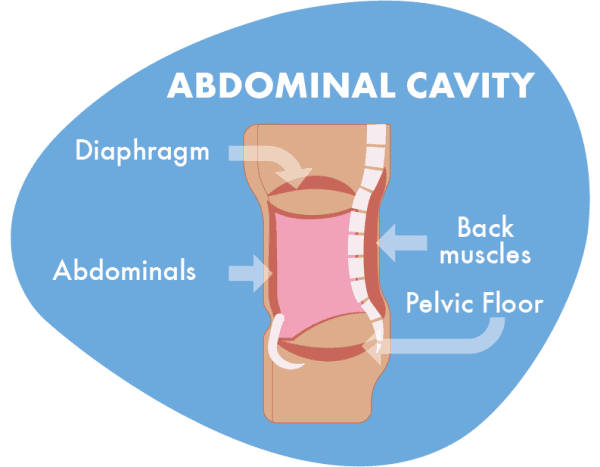Many health conditions can interfere with bladder function, contributing to Bladder weakness and unexpected leaks of urine. A relatively recent addition to this list is the COVID-19 virus. Common COVID-19 symptoms include a persistent cough and shortness of breath or difficulty breathing. But what on earth does that have to do with your pelvic floor?
If you have ever had a persistent cough, you might have a better understanding of the downside. Coughs and colds can all predispose you to accidental leaks of urine but a prolonged bout of covid could leave you despairing.
Fear not, there are things you can do to help. Let’s begin with what happens when we cough.
We can see that the diaphragm, intercostal muscles, and abdominal muscles all play a key part in this process. (A LoMauro and A Aliverti, 2019)
Now let’s examine the role of the pelvic floor when we cough or sneeze.
The abdominal cavity is a pressurised cylinder with a floor; the pelvic floor, a ceiling; the diaphragm, and walls; the abdominals, and back muscles. This system works in synergy to maintain the body in equilibrium.

The pressure in the abdominal cavity is increased by our everyday actions such as pushing, pulling, standing up from sitting, laughing, and coughing. (Yamasato at al. 2014)
The pelvic floor contracts in response to increases in intra-abdominal pressure (IAP). This is a reflex mechanism intended to resist the effects of pressure changes within the abdominal cavity that occur when we cough and sneeze or lift something heavy.
Astonishingly, the pelvic floor muscles can respond in anticipation of IAP pressure changes. This phenomenon is known as a fast feed-forward loop contraction or pre-contraction.
There are instances when this reflex activity of the pelvic floor is inadequate or absent altogether. This can contribute to leaks of urine when the intra-abdominal pressure is raised suddenly or unexpectedly.
Research by Berghmans and Seleme (2020) suggests that the importance of the feed-forward loop contraction or pre-contraction of the pelvic floor has been widely underestimated. However, it is an important element to consider as we train pelvic floor muscles.
Research has demonstrated that we can help the pelvic floor to withstand pressure changes by performing a strong active pelvic floor muscle contraction just before a voluntary cough or lifting something we know is heavy. This timely, rapid and strong pelvic floor muscle contraction was termed ‘The Knack’ by Miller et al (1998).
This strategy can certainly help to support the maintenance of continence if we can feel the cough or sneeze approaching, but it can also help if applied partway through a peal of coughs; several coughs occurring in rapid succession.
It is important to contract the pelvic floor in the correct way at the correct time. If you are unsure whether you are doing this correctly, please refer to our earlier article Strengthen your pelvic floor, why bother? to be certain that you are contracting the right muscles in the right way.
Now, join in and practice ‘the knack’ together.
Being able to apply ‘The Knack’ when needed could make all the difference to your confidence to deal with winter coughs, colds, and even an unfortunate encounter with COVID-19. It is a technique that we can use in addition to daily pelvic floor muscle training to maintain continence and prevent leaks of urine.
It is important to get professional help for any problem that is affecting your quality of life. If you seek help sooner rather than later, it will improve your chances of a positive outcome and can prevent a worsening of your condition.
To Sum Up
We hope you are feeling more confident about the steps you can take to improve your pelvic health. It is important to act sooner rather than later to improve your symptoms and prevent a worsening of your condition. Always seek out professional help if your symptoms are affecting your quality of life and/or not responding to simple self-help measures.
Hello, I’m Phillipa Butler, a Chartered Physiotherapist and Certified Pilates and Yoga Teacher.
My philosophy in my own life is that prevention is better than cure, so I believe that a regular programme of appropriate exercise is the key to a fitter, healthier future. Bladder weakness is no different, but it can be a bit trickier to get right.
I hope this blog will support you to arm yourself with some information and advice to take your health into your own hands.
Bary Berghmans, Maura Seleme. The ‘5 F’s Concept for Pelvic Floor Muscle Training: From Finding the Pelvic Floor to Functional Use. Journal of Women’s Health and Development 3 (2020): 131-134.
Miller JM, Ashton-Miller JA, DeLancey JO. A pelvic muscle precontraction can reduce cough-related urine loss in selected women with mild SUI. J Am Geriatr Soc. 1998 Jul;46(7):870-4. doi: 10.1111/j.1532-5415.1998.tb02721.x. PMID: 9670874.
Antonella LoMauro, Andrea Aliverti, Respiratory muscle activation and action during voluntary cough in healthy humans, Journal of Electromyography and Kinesiology,
Volume 49, 2019, 102359, ISSN 1050-6411,
https://doi.org/10.1016/j.jelekin.2019.102359.
De Keulenaer BL, De Waele JJ, Powell B, Malbrain ML. What is normal intra-abdominal pressure and how is it affected by positioning, body mass and positive end-expiratory pressure? Intensive Care Med. 2009 Jun;35(6):969-76. doi: 10.1007/s00134-009-1445-0. Epub 2009 Feb 26. PMID: 19242675.
Yamasato KS, Oyama IA, Kaneshiro B. Intraabdominal pressure with pelvic floor dysfunction: do postoperative restrictions make sense? J Reprod Med. 2014 Jul-Aug;59(7-8):409-13. PMID: 25098032.
Bibliography
Addington WR, Stephens RE, Phelipa MM, Widdicombe JG, Ockey RR. Intra-abdominal pressures during voluntary and reflex cough. Cough. 2008 Apr 30;4:2. doi: 10.1186/1745-9974-4-2. PMID: 18447952; PMCID: PMC2427048.
This article was originally published on iD Direct and has been republished here with permission.
iD Direct is the flagship brand of Ontex's range of adult care personal hygiene solutions. With over 40 years of experience, Ontex has developed innovative personal hygiene solutions to deliver high quality, affordable products to our customers across the globe.
Ontex's iD brand of disposable continence solutions is developed using the latest innovation and technology to provide maximum discretion as well as keep you safe and secure through fast absorption technologies. It is through our products, our practices and our people that we have got you covered for all your continence needs. Try one of our products today and choose to be confident - choose iD!


